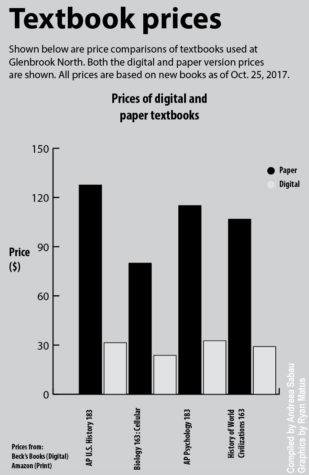Textbook trend toward digital evokes mixed feelings
After his AP Biology half block, senior Josh Genender rushes into his AP Calculus BC class, clutching his biology textbook in one hand and his calculus textbook in the other. He has embraced paper textbooks after an unsatisfactory experience with his digital AP U.S. History textbook last year.
“I despised [the eTextbook], but I couldn’t find a paper copy that was under $300,” Genender said.
Rosanne Williamson, assistant superintendent for educational services, said in a phone interview that Glenbrook North has adopted more digital textbooks over the last several years. However, the primary factor the administration considers in choosing a textbook is what material is most “valuable” to students, not necessarily the format or price of the book. Depending on the difference in price between print and digital, cost may influence the decision.
“I think it would be challenging for families if we find a resource out there that teachers feel good about, … but we’ve got a print book that’s $230 and we’ve got a digital version for $30,” said Williamson. “That’s a hard argument to make for print versus digital when we see those kinds of numbers.”
Marisa Bluestone, director of communications for the Association of American Publishers, said in a phone interview that publisher revenue from selling digital materials, such as eTextbooks, has increased by 12 percent from 2014 to 2016. Although profits collected by publishers do not necessarily indicate whether people prefer digital over print, the increase confirms that schools are buying more digital textbooks.
Genender said he purchased used paper textbooks for all of his classes this year, even for classes that do not offer a paper version at the Beck’s Book Store’s GBN location. With paper textbooks, he has experienced fewer technology issues and better memory retention.
“A book can’t shut down,” said Genender. “It can’t lose battery.
“I’m able to actually move [the paper textbook] with my hand, I can highlight what I’m reading … and I can take notes in the textbook, which helps me remember stuff.”
According to Naomi Baron, professor of linguistics at American University, an international study she conducted from 2013 to 2015 revealed that 92 percent of university students said they concentrated best when reading print. Because computers were made to help people complete tasks more quickly, she believes students read faster digitally and are less likely to question the text and develop critical thinking skills.
Social studies teacher Robin Sheperd said she has not seen a decrease in performance on tests and quizzes since her classes adopted a digital textbook. Although she recognizes that students may use the “find” function on computers to only read for key terms, she believes eTextbooks have not introduced using shortcuts because students could previously look up the term in the glossary of a paper textbook.
Baron said an important benefit of digital reading is adaptive learning. The digital textbook allows students to take interactive quizzes in order to determine what concepts they need to further review. Nevertheless, she believes paper textbooks have certain qualities that cannot be replaced.
“Holding [a paper book] in your hand, feeling a tactile connection to what you’re reading, … there’s a sense of place in a book,” Baron said.
Genender said he believes publishers are gravitating toward digital books because they cost less to produce and that a more widespread shift is inevitable.
“With time, I’m going to have to get used to [digital textbooks],” said Genender. “I’m just hoping that in my time of education, I don’t have to.” 

